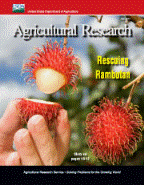United States Department of Agriculture: Agricultural Research Service, Lincoln, Nebraska

Agricultural Research Magazine
Date of this Version
8-2013
Document Type
Article
Citation
Agricultural Research 61(7): August 2013; ISSN 0002-161X
Abstract
Red imported fire ants are named for the firelike burn of their sting. Now, the same venom that packs such a painful wallop may actually do some good for a change.
Studies by scientists at the Agricultural Research Service’s Biological Control of Pests Research Unit in Stoneville, Mississippi, have shown that certain alkaloid compounds in the venom—namely, piperideines and piperidines—can hinder growth of Pythium ultimum, a top crop pathogen worldwide.
Chemical controls, delayed plantings, and crop rotation are among methods now used against P. ultimum, which causes damping-off diseases that decay the seed or seedlings of vegetable, horticultural, and cucurbit crops. Despite such measures, damping-off remains a costly problem, and new approaches are needed, notes Xixuan Jin, an ARS microbiologist. He coinvestigated the potential application of fire ant venom in the management of soilborne plant pathogens with ARS entomologist Jian Chen and Shezeng Li of the Institute of Plant Protection in Baoding, China.
Included in
Agriculture Commons, Animal Sciences Commons, Food Science Commons, Plant Sciences Commons

